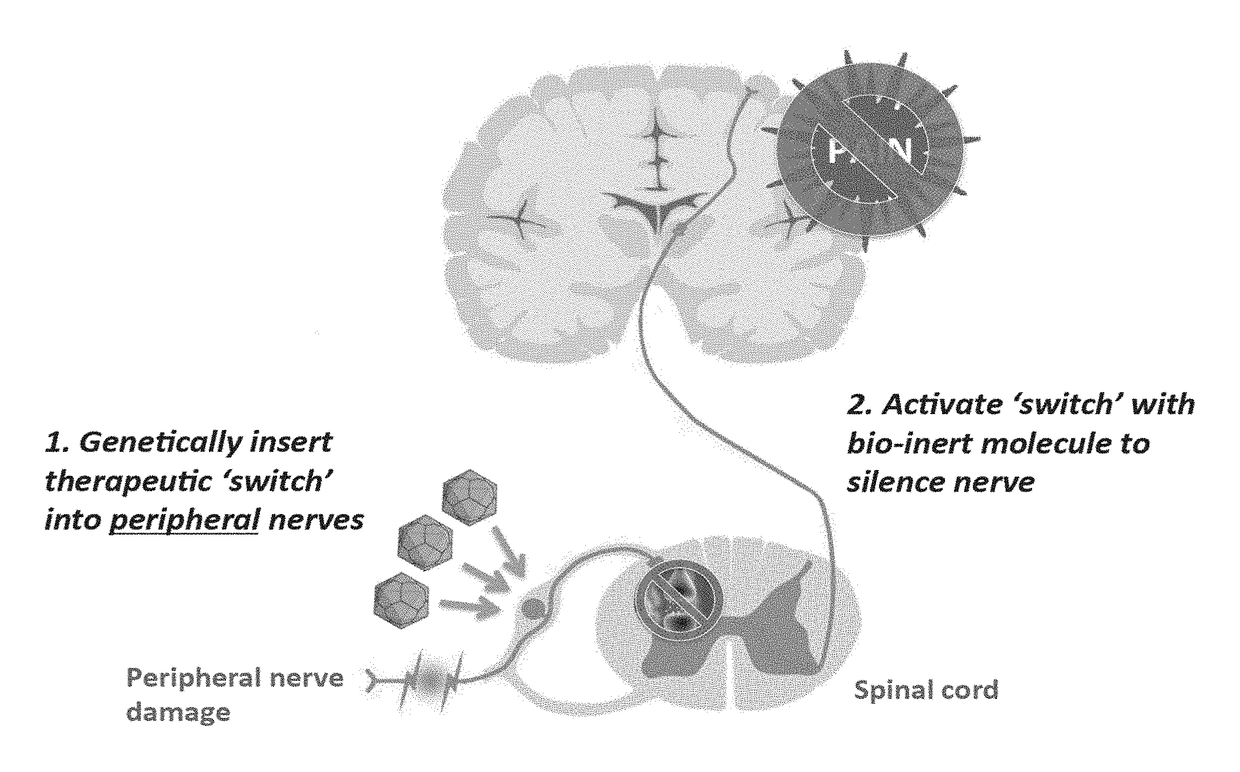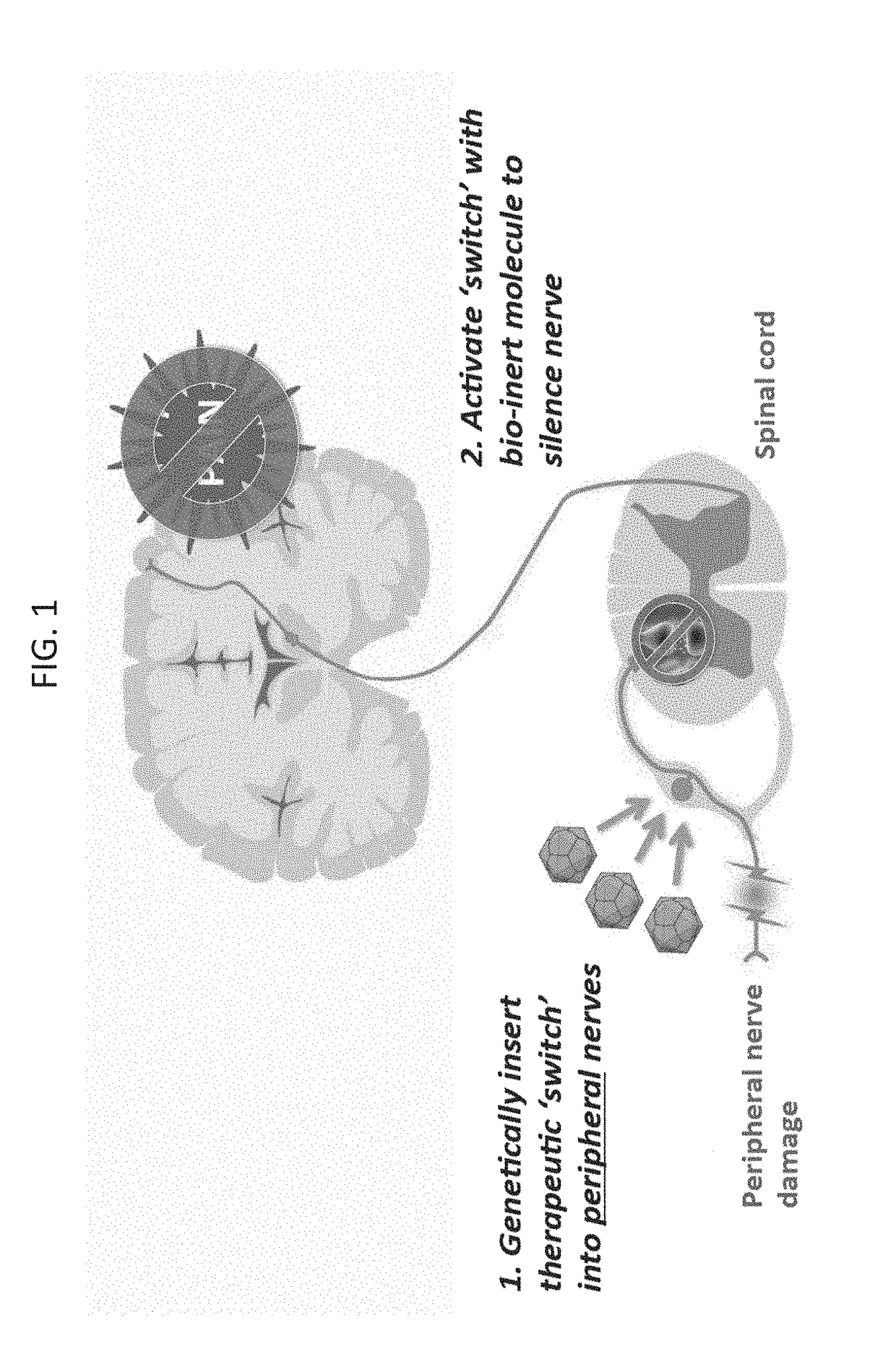Compositions and methods for treating neurological disorders
a technology of compositions and neurological disorders, applied in the field of compositions, can solve the problems of over $560 million in annual costs, significant financial burden of neurological disorders, critical health problems, etc., and achieve the effect of managing, preventing, or treating pain in a subj
- Summary
- Abstract
- Description
- Claims
- Application Information
AI Technical Summary
Benefits of technology
Problems solved by technology
Method used
Image
Examples
example 1
ion of hSYN1—GlyR αlpha1 F207A / A288G AAV Vectors
Cloning of V272-pFB-inCap6(Y705+Y731F+T492V)-inRep-Kan
[0406]A 390 bp cap6 fragment containing an introduced SbfI site and the mutation (T492V) is PCR amplified with primers 2793F and 2794R. A 440 bp cap6 fragment containing an introduced BsiWI site and the mutation (T492V) is PCR amplified with primers 2795F and 2796R. The amplification products are isolated by gel electrophoresis and purified.
[0407]The purified 390 bp and 440 bp PCR products are subjected to overlap PCR to generate a 810 bp cap6 fragment with primers 2793F and 2796R. The amplification product is isolated by gel electrophoresis and purified.
[0408]The purified 810 bp cap6 fragment is digested with SbfI and BsiWI and ligated into a V220 vector digested with SbfI and BsiWI to generate V272-pFB-inCap6(Y705+731F+T492V)-inRep-Kan.
Primer Sequences:
[0409]
PrimerPrimer Sequence 5′ to 3′SEQ ID NO:2793FATAGGACCCTGCAGGTATAC162794RCGTTTCTAAAGTAAAAACAGACAACAACAA172795FCTGTTTTTACTTTAG...
example 2
of Rodent Models of Chronic Pain
Chronic Pain Induction and Treatment
[0415]Day 0: Chronic pain is induced in rodent trigeminal ganglia or dorsal root ganglia using an established peripheral nerve injury method such as the chronic constriction injury (CCI, CO / CFA) or spared nerve injury (SNI) models. See Bennett & Xie. Pain. 1988, Decosterd & Woolf Pain. 2000, and Imamura, Kawamoto, & Nakanishi. Exp. Brain Res. 1997. In some instances, nerve injury may occur after viral vector injection.
[0416]Day 7: Intraganglionic or intrathecal injection of 108-1010 vector genomes of AAV6(Y705F+Y731F+T492V)-HSYN-GLYR(F207A / A288G)-FLAG or AAV6-GLY(HSYN-GLYR(F207A / A288G)-FLAG in a volume of approximately 1.0-10 μL is performed in one or multiple dorsal root ganglia or trigeminal ganglia using published methods. See Vit, Ohara, Sundberg et al. Mol Pain. 2009 and Towne, Fischer, Kostic, et al. J Neurosci Methods. 2011, and Pertin, et al. Mol Pain. 2009.
[0417]Weeks 2-12 post CCI or SNI: Ivermectin is adm...
example 3
of a Patient Suffering from Chronic Pain
[0421]A patient suffering from chronic pain is treated using the compositions and methods disclosed herein. The patient is treated on Day One with 1015 vector genomes of AAV-hSYN1-hM4Di in a volume of 12.0 mL into the subarachnoid space of the spinal cord (i.e., intrathecal). In this example, the AAV vector encodes the human muscarinic DREADD, hM4Di, under the control of the human Synapsin-1 (SYN1) promoter for selective neuronal expression. Two weeks post-injection, the patient returns to the clinic for a prescription for clozapine-N-oxide (CNO). The patient self-administers 100 μM CNO orally as needed (i.e., during a pain episode).
PUM
| Property | Measurement | Unit |
|---|---|---|
| Tm | aaaaa | aaaaa |
| volume | aaaaa | aaaaa |
| volume | aaaaa | aaaaa |
Abstract
Description
Claims
Application Information
 Login to View More
Login to View More - R&D
- Intellectual Property
- Life Sciences
- Materials
- Tech Scout
- Unparalleled Data Quality
- Higher Quality Content
- 60% Fewer Hallucinations
Browse by: Latest US Patents, China's latest patents, Technical Efficacy Thesaurus, Application Domain, Technology Topic, Popular Technical Reports.
© 2025 PatSnap. All rights reserved.Legal|Privacy policy|Modern Slavery Act Transparency Statement|Sitemap|About US| Contact US: help@patsnap.com



